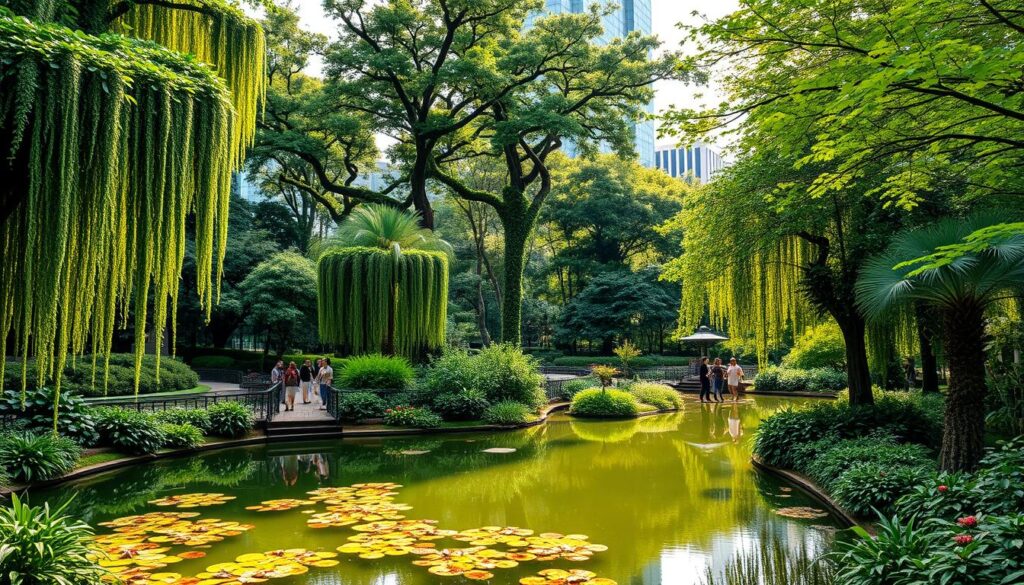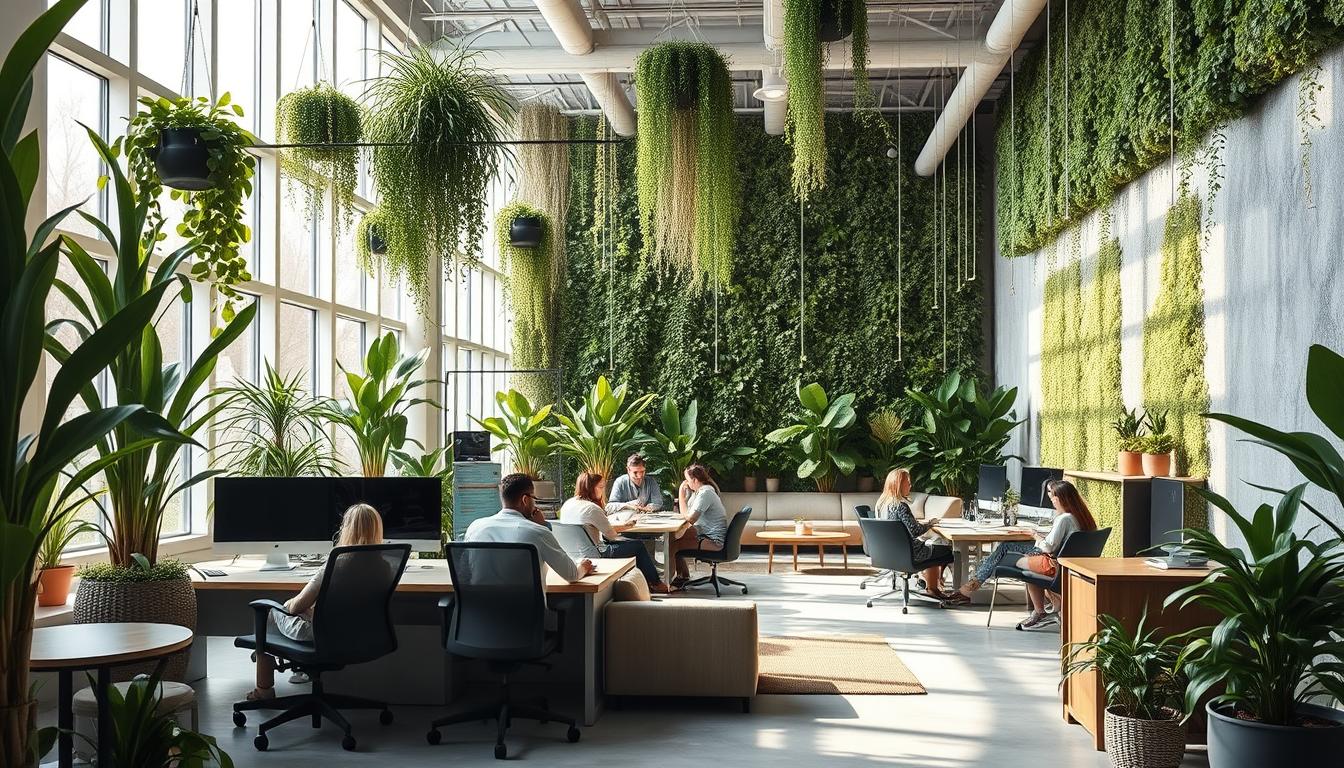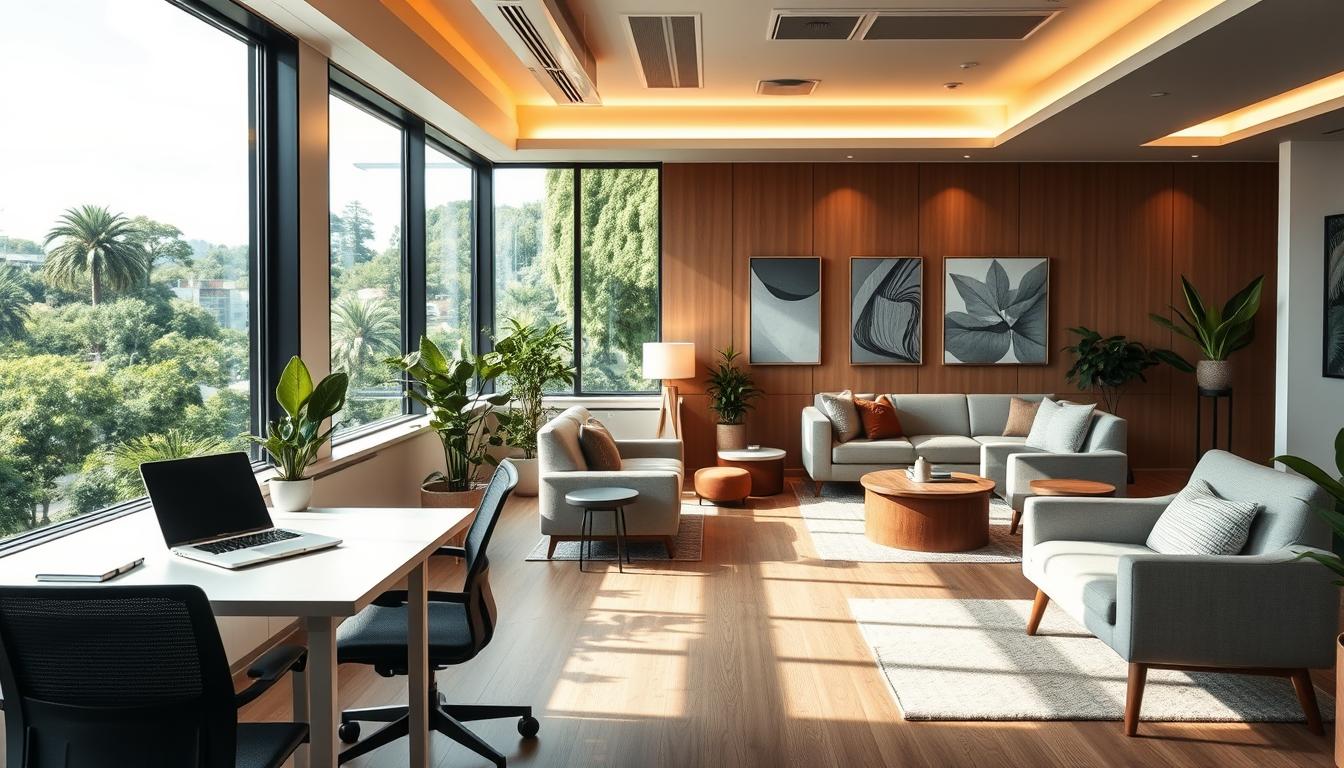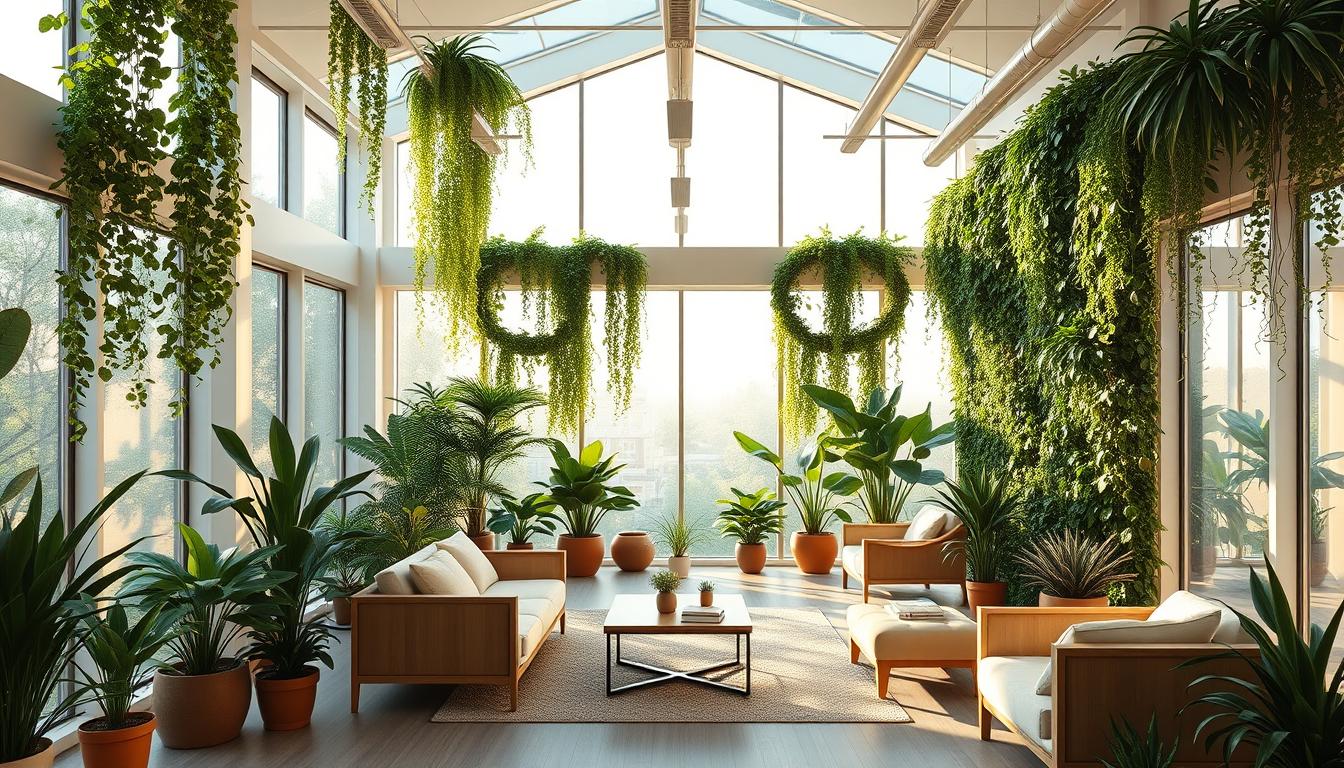Adding green spaces in cities helps keep temperatures in check. Cities often get hotter than nearby areas, a problem known as the urban heat island effect. This happens because city structures absorb and hold heat. To lower this heat, using plants and trees is key.
They cool down areas by giving shade and letting water evaporate from their leaves, which cools the air. By focusing on greenery, we make our communities nicer to live in and help the environment too.
The Importance of Urban Greenery
Urban greenery is key to making cities sustainable, comfortable, and livable. It cools down cities during hot weather, making the environment better. By adding green spaces, cities improve in looks and in ecology as they grow.
Green spaces are great for relaxing and for wildlife to live in. They help people feel closer to nature and improve mental health. Having parks nearby makes people more active, leading to a healthier life. More and more, people want green areas included in city plans.

Understanding Urban Heat Islands
Urban heat islands (UHIs) are a big problem in city climates today. They happen when local temperatures go up due to people’s actions and city structures. Cities get hotter than nearby rural places, causing both environmental and health issues.
Definition and Impact on Cities
Urban heat islands make city areas hotter because of buildings and little green space. This leads to more energy use, bad air quality, and more pollutants. High temperatures can harm health, especially during heatwaves, hitting vulnerable people hard.
Factors Contributing to Urban Heat Islands
Several things cause urban heat islands. Key causes include:
- Large areas that don’t let water through, like roads and buildings. They soak up and hold heat.
- Not enough trees, which means less cooling from shade and evaporation.
- People’s activities that create heat, such as cars, factories, and using a lot of energy.
These factors make cities much warmer. It’s important to understand them to tackle urban heat islands effectively.
Benefits of Green Spaces in Urban Areas
Urban greenery improves air quality and boosts city dwellers’ health. By including enough green spaces, cities enjoy many perks from trees and plants. These advantages help clean the air and make people healthier.
Enhancing Air Quality
Green spots help make the air better by taking in carbon dioxide and giving out oxygen. Trees and plants act like big air filters. They catch bad particles, making the air in cities cleaner. Places with lots of green areas see fewer lung problems. This shows how important green spaces are.
Promoting Public Health and Well-being
Being near green areas brings health perks. People visiting parks often feel less stressed and happier. Outdoor activities promote exercise and getting together with others. This boosts the well-being of the community.
How Trees Contribute to Cooling
Trees are very important in cities. They offer tree shade benefits that cool down the areas around them. They can make spaces under them much cooler compared to sunny spots. Trees can lower temperatures by 3°C to 19°C, making cities nicer places in summer.
Temperature Reduction through Shade
Cooling effects of shade are clear benefits of having trees around. Places with lots of trees can be much cooler. This makes it easier for everyone moving around in cities to stay comfortable even when it’s hot.
Evapotranspiration Effect
Evapotranspiration also helps trees cool areas down. It’s when water evaporates from soil and leaves, releasing moisture into the air. This cool moisture makes the air fresher, helping to keep temperatures down. Thanks to this, trees can make the city feel more pleasant.
Temperature Stabilization through Greenery
Adding greenery to cities is key for controlling temperatures. Cities often get too hot due to lots of buildings and few trees. Plants can bring a cooling effect that’s much needed.
Studies show that just a 10% increase in green spaces can lower temperatures by about 0.5°C. This helps keep it cooler during the day and night, making cities more comfortable.
To cool areas, cities can plant trees and make parks. These provide shade and help the air stay moist. When plants release water into the air, they cool down the place around them.
Cities must invest in more green spaces to fight against hotter temperatures. More greenery not only helps with the heat but also makes the air cleaner and improves how we feel.
Green Roofs and Their Cooling Effects
Green roofs bring together building design and nature to cool city heat. These roofs have plants, soil, and a way to drain water. They keep buildings warm or cool when needed, cutting down on air conditioner use. This makes cities more green and eco-friendly.
Understanding Green Roof Technology
Green roofs work by holding water and insulating buildings. They have plants and soil that manage heat well. These roofs soak up sunlight, stopping too much heat. They also help nature by welcoming different plants and animals and controlling rainwater.
Impact on Urban Temperature Levels
Green roofs play a big role in lowering city heat. Studies show buildings with green roofs are cooler on the outside and inside. This is really clear in the summer. A good green roof makes the area around it nicer and helps control city temperatures.
Water Features and Their Role in Cooling
Water features are key in making hot city places cooler, making them more livable. They include things like ponds, fountains, and lakes. These features help raise local humidity and cool the air by evaporation. Knowing about different water features and how they cool things down is key for city design.
Types of Water Features
Urban areas can have different water features. Each has its own way to help cool down temperatures:
- Ponds
- Fountains
- Lakes
- Streams
- Waterfalls
Evaporation and Temperature Control
Evaporation from water surfaces helps lower the heat around them. It takes in heat energy to boost the cooling effect. This is really helpful during the warmest times of the day. Adding water features to city planning is essential. Combining water and green spaces improves city climates. It also makes city living better for everyone.
Landscaping Choices for Temperature Control
Choosing the right plants in cities helps control temperature. They reduce heat and make the air cleaner. Using local plants is good for the earth and people.
Native Plants and Their Benefits
Local plants need less water and care, and they’re good for the soil and animals. They help in many ways:
- They use less water because they can handle dry conditions.
- They don’t need much fertilizer or pesticide, which is better for nature.
- They create shade, helping cool the area.
- They’re strong against bugs and sickness.
Design Strategies for Effective Green Spaces
To make cool, green places, keep these tips in mind:
- Place trees and bushes to shade areas.
- Have open spots for wind to bring cool air.
- Use different kinds of plants to keep the environment healthy.
- Add features like ponds for cooling by water evaporating.
With these ideas, city planners can make places cooler and better. They focus on green projects that help everyone.
Economic Benefits of Urban Greening
Urban greening brings more than beauty; it also brings economic benefits to communities. It shows us how green spaces can transform neighborhoods and support local economies.
Increased Property Values
Studies have found that homes near parks and green areas are worth more. Nature around homes makes life better for people, making these areas more desirable. These factors, like nicer looks, less noise, and a happier community, lift home values.
Cost Savings on Energy Bills
Greening cities can also cut energy bills. Trees and plants provide shade and cool the air, reducing the need for air conditioning. Homeowners save money and enjoy a nicer living area with less energy use.
Community Engagement and Greenery
For urban greening projects to work, the community must take part. When locals dive into these projects, they do more than plant trees. They build a stronger bond with their surroundings. This strong bond helps the community care for these green spots long-term.
Encouraging Local Participation in Greening Efforts
Cities can get people involved by setting up activities. These can range from teaching how to care for plants to cleaning up neighborhoods. They can even include school programs teaching kids about looking after the environment.
- Workshops on planting and caring for urban greenery
- Neighborhood clean-up events
- Collaborations with local schools to create educational programs about environmental stewardship
This hands-on approach means communities play a direct role in adding greenery. The result is greener spaces that mirror the community’s unique identity.
Creating Awareness about Urban Heat Issues
Educating folks on the risks of urban heat islands is crucial. Campaigns and programs can show how green spaces can fight this heat. Key moves include:
- Host informational sessions that highlight the benefits of increased greenery in urban settings.
- Utilize social media to promote the importance of community involvement in greening efforts.
- Engage local leaders to advocate for sustainable practices in urban planning.
With these approaches, communities learn to improve their surroundings. They tackle heat issues and boost their living quality by getting involved.
Challenges to Increasing Urban Green Spaces
Urban areas face big hurdles when trying to add more green space. As more people move to cities, the need for homes and roads grows. This makes it hard to add parks and plants to our cities. To overcome these problems, city planners and leaders must think of new ways.
Space Limitations in Urban Areas
Cities often don’t have enough room for green spots. With so many people living close together, it’s tough to find space for parks. But, creative ideas are helping solve this issue:
- Vertical gardens: Using the sides of buildings for plants saves space.
- Pocket parks: Tiny green spots can brighten up areas full of concrete.
- Rooftop gardens: These not only look nice but also help control temperatures.
Biodiversity Considerations
When we work on urban green space, we also need to think about the plants and animals that live there. Cities usually don’t have a lot of different plants and animals. This can throw off the balance of nature. Good design for green spaces should focus on:
- Using plants native to the area to help local wildlife.
- Making spaces that let different species flourish, creating a better ecosystem.
- Linking green spots together so animals can move around easily.
By paying attention to both green spaces and biodiversity, cities can better handle their challenges. This approach makes urban areas sustainable for the future.
Case Studies of Successful Urban Greening
In big cities, urban greening shows how well-thought-out plans can lead to projects that help both people and nature. Places like New York and San Francisco have started big projects to add more green spaces. These projects reduce city heat and get more people involved.
Examples from Major US Cities
New York City’s MillionTreesNYC aimed to plant a million trees across its boroughs. This effort changed the city’s look and got people involved in caring for trees. San Francisco’s Urban Forest Plan works to increase trees to better air quality and support wildlife.
Lessons Learned and Best Practices
Learning from these urban greening projects points out important lessons:
- Getting the community involved is key to keeping urban green spaces.
- Picking local and various plants makes green efforts last longer and do better.
- Using smart designs makes green areas work better for cooling and being places people enjoy.
By focusing on these points, the good from green projects grows. It not just helps the planet but also brings people together, highlighting the diverse perks of green initiatives.
Conclusion
Putting plants into city designs is key for promoting sustainability and keeping cities cooler. We’ve seen that green cities lead to cleaner air, healthier people, and higher property values. These points show why we need greener, sustainable places for better living.
There are challenges, like not having enough space and keeping diverse plant life. But with smart design and community help, these issues can be solved. If cities and local people work together on green projects, they can beat the heat and enjoy their outdoor spaces more.
So, making our cities greener is not just about cooling them down. It’s about creating cities that last and are nice places to live. With dedication to green living and smart planning, we can make a cooler, better future for everyone.



